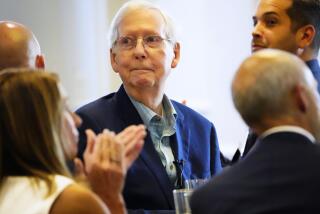‘60 Minutes’ Training : Course Hones Media Skills of Doctors
- Share via
In true Mike Wallace fashion, the “TV interviewer” fixed his gaze on the nervous-looking doctor and demanded in a cool, baritone voice whether physicians are “pushing pills in collusion with the pharmaceutical industry” and “experimenting with human beings.”
The scene could have been every interviewee’s nightmare, but it was only a simulation.
Eager to improve the medical community’s declining credibility, about 120 doctors from across the United States--including some prominent Southern California physicians--are honing their media skills this weekend at a $410-a-person course at the Sheraton Harbor Island East offered by the politically powerful American Medical Assn. (The fee is $295 for AMA members and $75 for medical students and residents.)
The course includes intense classes on everything from “Basic Scriptwriting” to “TV: Finding and Producing a Show” to “Radio: Producing, Editing and Interviewing” to “Advanced Scriptwriting” to “Speakers Bureau Training.”
Doctors must learn how to use the media to counter nasty press coverage of high medical costs and the Reagan Administration’s slashing of medical support programs, asserted Dr. John H. Dawson, a member of the Chicago-based AMA’s board of trustees.
“It is important that as many of us as possible become active in telling the good news about medicine. Heaven knows there are enough people telling the bad news,” Dawson said.
Another reason for the annual course--now in its fifth year--is that a growing number of doctors are using the media to drum up business. Many hire agents who arrange interviews on local--and sometimes national--TV talk shows, where doctors can regale audiences of millions with their views on plastic surgery, mastectomies and mind-controlling drugs.
While course planners stressed that most reporters try to do a fair, honest job, they drew big laughs by lambasting more boorish reporters.
Doctors in one session gasped at a videotape of TV host Wally George grabbing an opinionated guest by the coat collar. The guest then flipped over George’s desk and stormed off the stage.
“You don’t need to deal with people such as this (George). There’s nothing that forces you to go on any talk show,” said Peter Jacobi, a former NBC-TV correspondent and one-time associate dean of Northwestern University’s journalism school. He now teaches at Indiana University.
On Friday morning, Jacobi made a three-hour presentation entitled “Lights, Camera, Action” on the do’s and don’ts of TV appearances. Among his tips were:
- Don’t fidget during an interview. Keep your feet planted on the floor. Don’t sit in a swivel chair that encourages body motion, and confine your gaze to a narrow area between the interviewer and the TV camera.
- Request makeup to minimize 5 o’clock shadow and other facial annoyances.
- Wear something red near one’s face. “It’s a warm, friendly color.” Avoid dark suits, as they look “heavy and funereal.” Also skip white outfits (which glow too brightly on-camera) and highly patterned outfits. And don’t forget the knee-length socks.
- Be friendly and enthusiastic: “Talk in story form.” Jacobi illustrated his point by showing a TV videotape of an actor, portraying a corporate official, who describes a fishing trip with his son to answer, in part, a reporter’s question about environmental safety.
- Try to limit answers to 15 to 30 seconds. A longer response might be edited, risking distortion.
- Say the most important thing first. This is another way to avoid having one’s most valuable insights edited out of the final footage.
- Sit forward. This way, you’ll look more enthusiastic--it also lessens the chance that you’ll start rocking back and forth, creating a distraction.
Jacobi tested two attendees by subjecting them to a mock interview conducted by a real radio reporter, Richard Kulp of the Stanford, Conn.-based Physicians Radio Network.
Mild-mannered neurologist Scott Tyler of Scottsdale, Ariz., was Kulp’s first victim. As a TV camera transmitted their images to two TV screens in the room, Kulp opened with a question worthy of “60 Minutes” at its meanest: Wasn’t Tyler “doomed” as a private practitioner, considering the national trend toward group practices?
Tyler smiled shyly and acknowledged that private practice “is a lost art.”
That response was a mistake--it was too downbeat, Jacobi later scolded.
The next target was retired general practitioner Dr. Richard Williamson of Huron, Ohio. Kulp opened the interview by sarcastically commenting that Williamson “got out (of medicine) while the getting was good,” considering recent pressure on physicians to control their fees.
Then, showing no mercy, he asked Williamson how he felt about claims that doctors set high rates “to maintain their life style” while “pushing pills in collusion with the pharmaceutical industry” and exploiting information obtained through cruel animal experiments.
Jacobi also warned the 18 doctors present at his seminar about journalists’ trickier questions. One is the “A and B” query, which requires the respondent to acknowledge one answer or the other, both of them ridiculous extremes. “It’s a favorite of the journalists because it limits the options and simplifies the story,” he said.
He also suggested quoting someone famous, such as George Bernard Shaw. He added with a laugh that “it always helps to quote Lincoln,” but Yogi Berra is even better because “he’s nonpartisan.”
Williamson said afterward that the class “fits in perfectly” with his effort to enhance his skills as a speaker back home. “I don’t feel that being 70 years old is like being on a shelf,” he said. “I will use what I’ve learned for TV appearances, for speaking, for whatever destiny holds in store for me.”
Dr. Michael E. Peter of Torrance said he took the class because “I’m often asked to speak in the community . . . . There are lots of questions raised about medicine nowadays--questions about costs, the quality of care . . . and physicians ought to be better able to answer them.”
More to Read
The complete guide to home viewing
Get Screen Gab for everything about the TV shows and streaming movies everyone’s talking about.
You may occasionally receive promotional content from the Los Angeles Times.






